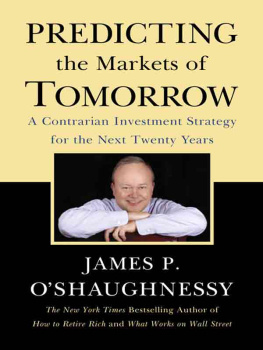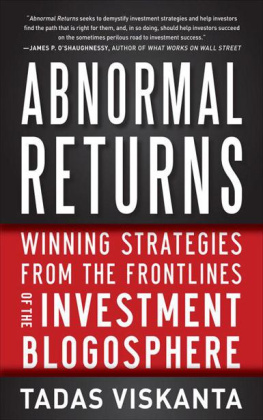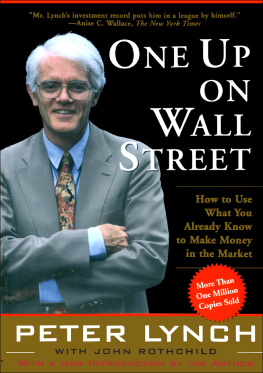Predicting the Markets of Tomorrow
A Contrarian Investment Strategy for the Next Twenty Years
James P. OShaughnessy
PORTFOLIO
For my mother and father
PORTFOLIO
Published by the Penguin Group
Penguin Group (USA) Inc., 375 Hudson Street, New York, New York 10014, U.S.A. Penguin Group
(Canada), 90 Eglinton Avenue East, Suite 700, Toronto, Ontario M4P 2Y3, Canada (a division of Pearson
Penguin Canada Inc.) Penguin Books Ltd, 80 Strand, London WC2R 0RL, England Penguin Ireland,
25 St. Stephens Green, Dublin 2, Ireland (a division of Penguin Books Ltd) Penguin Books Australia Ltd,
250 Camberwell Road, Camberwell, Victoria 3124, Australia (a division of Pearson Australia Group Pty
Ltd) Penguin Books India Pvt Ltd, 11 Community Centre, Panchsheel Park, New Delhi110 017, India
Penguin Group (NZ), Cnr Airborne and Rosedale Roads, Albany, Auckland 1310, New Zealand
(a division of Pearson New Zealand Ltd) Penguin Books (South Africa) (Pty) Ltd, 24 Sturdee Avenue,
Rosebank, Johannesburg 2196, South Africa
Penguin Books Ltd, Registered Offices:
80 Strand, London WC2R 0RL, England
First published in 2006 by Portfolio, a member of Penguin Group (USA) Inc.
Copyright James P. OShaughnessy, 2006
All rights reserved.
Authors Note
This book does not constitute investment advice from the author, his employer, or other information providers. This book contains statements and statistics that have been obtained from sources believed to be reliable, but neither the author nor the information providers can guarantee the accuracy, completeness, or timeliness of any of the information in this book, including, but not limited to, information originating with the author, licensed by the author from information providers, or gathered by the author from publicly available sources. Neither the author nor the information providers make any representations about the suitability of the information contained in this book, nor shall have any liability, contingent or otherwise, for any decision made or action taken by the reader in reliance upon such information. This book contains various forward-looking statements based on the authors projections, hypotheses, forecasts, estimates, beliefs, and prognosis about future events. All forward-looking statements contained herein reflect solely the authors opinions about such future events and are subject to significant uncertainty. Actual events may differ materially from those described in such forward-looking statements.
Publishers Note
This publication is designed to provide accurate and authoritative information in regard to the subject matter covered. It is sold with the understanding that the publisher is not engaged in rendering legal, accounting, or other professional services. If you require legal advice or other expert assistance, you should seek the services of a competent professional.
ISBN: 978-1-1012-1838-9
Without limiting the rights under copyright reserved above, no part of this publication may be reproduced, stored in or introduced into a retrieval system, or transmitted, in any form or by any means (electronic, mechanical, photocopying, recording or otherwise), without the prior written permission of both the copyright owner and the above publisher of this book.
The scanning, uploading, and distribution of this book via the Internet or via any means without the permission of the publisher is illegal and punishable by law. Please purchase only authorized electronic editions and do not participate in or encourage electronic piracy of copyrightable materials. Your support of the authors rights is appreciated.
Preface
I know of no way of judging of the future but by the past.
Patrick Henry
In March of 2000, the S&P 500 marked its highest twenty-year real rate of return in over one hundred years. U.S. intermediate-and long-term government bonds reached the same high-water mark a year and a half later in September 2001. On the way to this summit, investors created one of the largest bubbles in history for trendy, new-era stocks and lived by the mantra that it was different this time. Near the end of this one-hundred-year flood in financial markets, many respected advisors were strongly recommending that investors allocate the bulk of their assets to large capitalization growth and technology stocks. Enthusiastic investors bid profitless companies to unprecedented valuations on little more than the ever-present hope that it really was different this time! It was widely accepted that a new era had dawned on Wall Street, requiring investors to throw out the old valuation rules and start using new metrics to price stocks according to their true value.
Simultaneously, the shares of small-and mid-cap stocks, as well as large capitalization value stocks, lagged both the S&P 500 and large capitalization growth stocks by the widest margins seen in the last seventy-seven years. What virtually every investor of the era knew through their experience in the market was that only a handful of the right stockslarge-cap growth or technology issues, or for the more conservative, an index fund mirroring the S&P 500would be the ticket to continued double-digit growth for the foreseeable future.
Its time for investors to be reeducated.
I believe that what investors have learned over the past twenty years has clouded their expectations about what returns they might expect over the next twenty years, particularly concerning what types of stocks and bonds will offer the highest returns. Careful analysis of long-term data shows us that financial markets have reached such great heights on several occasions in the past century. It is very instructive to look at what happened after each of these zeniths. Close examination of one hundred years of market data allows us to predict what might be in store over the next twenty years. Studying the markets of yesterday can help us understand the markets of tomorrow.
I hope that this book will be a call to action for investors who dont want to be left behind, and to all investors who want to reap the highest returns that the market might offer in the coming two decades.
The stakes could hardly be higher. We are facing a triple threat to our investment health: the future of Social Security is cloudy, corporate pension plans are massively underfunded, and many baby boomers failure to save for retirement has left them frantically scrambling to find a way to a secure retirement. And despite Americans fascination with the stock market over the past few decades, most are still financially illiterate. An April 27, 2005, article in the New York Times reported on a survey showing that the typical American knows virtually nothing about the economy or about how the stock market works. The article notes that about half of American adults did not know that if they kept their money at home, in cash, they were at greater risk of losing ground to inflation than if they invested elsewhere. Whats more, the average American gives very little thought to what he or she will need for retirement. According to a survey by the Principal Financial Group Inc., just 42 percent of American workers have done calculations to figure out if they are saving enough for retirement.
In all three of my previous books I have sought to understand why certain stocks go up while others decline. In What Works on Wall Street, I found that Wall Street consistently and methodically rewards securities with certain attributes just as surely as it punishes those with others. But it was only by looking at very long periods of datafifty-two years for What Works on Wall Street that this proved to be true. If you look at very short periods of time, what you see is meaningless noise. One five-year period would show small stocks performing well, another would show large-cap growth stocks on fire, a third might recommend value. When looking at the fullness of time, however, you see that certain types of stocks perform vastly better than othersand that there was a good reason for their superior performance.








